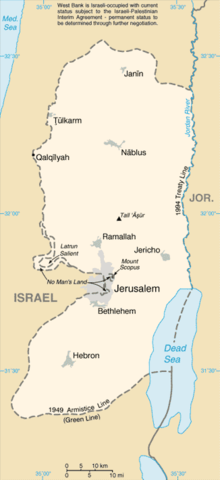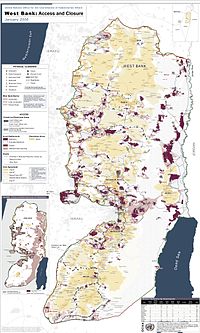کرانه باختری
کرانه باختری (عربی: الضفة الغربیة؛ عبری: הַגָּדָה הַמַּעֲרָבִית, romanized: HaGadáh HaMaʽarávit)، منطقهای در غرب آسیا، واقع در سرزمین تاریخی شام است که به همراه نوار غزه، سرزمینهای فلسطینی را تشکیل میدهند و از سال ۱۹۶۷، تحت اشغال اسرائیل قرار دارند. این سرزمین، به سبب اینکه در غرب رود اردن قرار دارد، به کرانه باختری شهرت پیدا کرده است.[۵] اردن و دریای مرده در شرق و اسرائیل (از طریق خط سبز) در جنوب، غرب و شمال آن قرار دارند.[۶]
کرانه باختری الضفة الغربیة הגדה המערבית | |
|---|---|
 موقعیت کرانه باختری در قلمرو مورد ادعای دولت فلسطین | |
| وضعیت |
|
| زبان(های) رایج | زبان عربی، عبری نوین |
| دین(ها) | اسلام، یهودیت، مسیحیت، سامریگرایی |
| مساحت | |
• کل | ۵٬۶۵۵ کیلومتر مربع (۲٬۱۸۳ مایل مربع) |
| جمعیت | |
• برآورد سال ۲۰۲۱ | ۲٬۹۴۹٬۲۴۶[ب] |
• تراکم | ۵۲۲ بر کیلومتر مربع (۱٬۳۵۲٫۰ بر مایل مربع) |
| واحد پول | شکل جدید اسرائیل (ILS) دینار اردن (JOD) |
| منطقه زمانی | یوتیسی+۲ (Palestine Standard Time) |
• تابستان (ساعت تابستانی) | یوتیسی+۳ (Palestine Summer Time) |
| پیششماره تلفنی | +۹۷۰ |
| کد ایزو ۳۱۶۶ | PS |


پس از شکست نیروهای امپراتوری عثمانی از بریتانیا در جنگ جهانی اول، دولت وقت بریتانیا در ۲۵ آوریل ۱۹۲۰ میلادی کنترل کرانه باختری را بههمراه دیگر سرزمینهای فلسطین برعهده گرفت و با تشکیل یک سیستم حکومتی تحت عنوان قیومیت بریتانیا بر فلسطین بهکنترل کرانه باختری و دیگر مناطق فلسطین پرداخت. پس از جنگ استقلال اسرائیل در سال ۱۹۴۸ میلادی و تأسیس اسرائیل در بخشی از سرزمینهای تحت قیومیت بریتانیا و تصرف کرانه باختری توسط ارتش اردن، پیمان صلح موقت ۱۹۴۹ میان رژیم تازه تأسیس اسرائیل و مصر، اردن، سوریه و لبنان به امضا رسید که بنابر مفاد آن مرزهای اسرائیل و فلسطین مشخص شده و کرانهٔ باختری تحت کنترل کشور اردن قرار گرفت. این عهدنامه تا آغاز جنگ شش روزه در سال ۱۹۶۷ اجرا میشد و پس از شکست اعراب از اسرائیل، کرانه باختری در اشغال نظامی ارتش اسرائیل بوده است.
کرانه باختری مرکز درگیری فلسطین و اسرائیل باقی مانده است. فلسطینیان آن را در کنار نوار غزه قلب کشوری که برای خود تصور میکنند میدانند. اسرائیلیهای دست راستی و مذهبی آن را موطن آبا و اجدادی خود، که مکانهای بی شماری در کتاب مقدس شان دارد میدانند. در میان بعضی اسرائیلیها تلاشی برای ضمیمه کردن کامل یا جزئی این سرزمین وجود دارد. علاوه بر این، این سرزمین خانه شمار در حال افزایشی از شهرک نشینان اسرائیلی است.[۷] بر پایهٔ آمارهای رسمی بین ۲۲۰ هزار[۸] تا ۳۰۰ هزار[۹] شهرکنشین اسرائیلی در ناحیه سی کرانهٔ باختری رود اردن که قانون اسرائیل در آن اعمال میشود زندگی میکردند، منطقه ای که بنا بر پیمانهای اسلو قرار بود کنترل آن تا سال ۱۹۹۷ تقریباً کاملاً به تشکیلات خودگران فلسطین منتقل شود، ولی این اتفاق رخ نداد.[۱۰] جامعه بینالمللی شهرکهای اسرائیلی در کرانه باختری را بر اساس حقوق بینالملل غیرقانونی میداند.[۱۱][۱۲][۱۳][۱۴] یک حکم مشورتی دیوان بینالمللی دادگستری در سال ۲۰۰۴، با استناد به قانون ۱۹۸۰ که در آن اسرائیل نسبت به اورشلیم به عنوان پایتخت خود ادعا کرد، پیمان صلح ۱۹۹۴ اسرائیل و اردن، و پیمانهای اسلو، نتیجهگیری کرد که کرانه باختری از جمله بیتالمقدس شرقی همچنان سرزمینهای اشغالشده توسط اسرائیل هستند.[۱۵]
مناطق پرجمعیت
ویرایش| مناطق | جمعیت |
|---|---|
| البیره | ۴۵۹۷۵ |
| بیتار ایلیت | ۶۴۰۱۵ |
| بیتلحم | ۳۰۰۰۰ |
| گاش اتزیون | ۴۰۰۰۰ |
| الخلیل | ۲۱۵۰۰۰ |
| اریحا | ۲۵۰۰۰ |
| اورشلیم شرقی | ۴۰۰۰۰۰ |
| جنین | ۴۷۰۰۰ |
| معاله آدومیم | ۳۱٬۷۰۰ |
| مودیین الیت | ۳۴۵۱۴ |
| نابلوس | ۱۳۵۰۰۰ |
| قلقیلیه | ۴۰۰۰۰ |
| رامالله | ۶۰۰۰۰ |
| طولکرم | ۷۵۰۰۰ |
| یاتاه | ۴۲۰۰۰ |
| آریل | ۱۶٬۹۰۰ |
از مهمترین مناطق پرجمعیت در کرانه باختری میتوان به شهرهای نابلس، آریل، ابودیس، رامالله، البیره، معاله آدومیم، بیتلحم، بعیتار ایلیت، گاش اتزیون، الخلیل، توباس و یاتاه اشاره کرد. شهر جنین در شمال کرانه باختری و در مجاورت شهرهای عربنشین قلقیلیه و طولکرم قرار دارد. همچنین شهر فلسطینینشین اریحا در شمال دریای مرده قرار دارد.
جستارهای وابسته
ویرایشیادداشت
ویرایش- ↑ دولت فلسطین، از سوی ۱۴۳ عضو سازمان ملل متحد به رسمیت شناخته شده است.
- ↑ بیش از ۶۷۰٬۰۰۰ شهرکنشین اسرائیلی در به تاریخ سال ۲۰۲۲ زندگی میکردهاند؛ تقریباً ۲۲۷٬۱۰۰ اسرائیلی شهرک نشین در اورشلیم شرقی به تاریخ ۲۰۱۹ زندگی میکردهاند.[۴]
پانویس
ویرایش- ↑ "Ban sends Palestinian application for UN membership to Security Council". United Nations News Centre. 23 September 2011. Archived from the original on 10 October 2015. Retrieved 11 September 2015.
- ↑ "Mideast accord: the overview; Rabin and Arafat sign accord ending Israel's 27-year hold on Jericho and the Gaza Strip" بایگانیشده در ۹ دسامبر ۲۰۲۰ توسط Wayback Machine. Chris Hedges, New York Times, 5 May 1994.
- ↑ Roberts, Adam (1990). "Prolonged Military Occupation: The Israeli-Occupied Territories Since 1967" (PDF). The American Journal of International Law. 84 (1): 85–86. doi:10.2307/2203016. JSTOR 2203016. S2CID 145514740. Archived from the original (PDF) on 2020-02-15.
The international community has taken a critical view of both deportations and settlements as being contrary to international law. General Assembly resolutions have condemned the deportations since 1969, and have done so by overwhelming majorities in recent years. Likewise, they have consistently deplored the establishment of settlements, and have done so by overwhelming majorities throughout the period (since the end of 1976) of the rapid expansion in their numbers. The Security Council has also been critical of deportations and settlements; and other bodies have viewed them as an obstacle to peace, and illegal under international law... Although East Jerusalem and the Golan Heights have been brought directly under Israeli law, by acts that amount to annexation, both of these areas continue to be viewed by the international community as occupied, and their status as regards the applicability of international rules is in most respects identical to that of the West Bank and Gaza.
- ↑ "West Bank". Central Intelligence Agency. 17 October 2023. Archived from the original on 22 July 2021. Retrieved 25 December 2021 – via CIA.gov.
- ↑ "West Bank", The World Factbook (به انگلیسی), Central Intelligence Agency, 2022-09-27, archived from the original on 22 July 2021, retrieved 2022-09-30
- ↑ "Middle East: West Bank". The World Factbook. Central Intelligence Agency. 26 September 2018. Archived from the original on 22 July 2021. Retrieved 3 October 2018.
- ↑ "The A to Z of the Arab-Israeli conflict". The Economist. ISSN 0013-0613. Archived from the original on 21 November 2023. Retrieved 2023-11-21.
- ↑ اسرائیل در کرانه باختری برای یهودیان مسکن جدید میسازد، بیبیسی فارسی
- ↑ آمادگی ضمنی اسرائیل برای توقف شهرکسازیها، دویچه وله فارسی
- ↑ World Bank 2013, p. vii.
- ↑ Roberts, Adam (1990). "Prolonged Military Occupation: The Israeli-Occupied Territories Since 1967" (PDF). The American Journal of International Law. 84 (1): 85–86. doi:10.2307/2203016. JSTOR 2203016. S2CID 145514740. Archived from the original (PDF) on 2020-02-15.
The international community has taken a critical view of both deportations and settlements as being contrary to international law. General Assembly resolutions have condemned the deportations since 1969, and have done so by overwhelming majorities in recent years. Likewise, they have consistently deplored the establishment of settlements, and have done so by overwhelming majorities throughout the period (since the end of 1976) of the rapid expansion in their numbers. The Security Council has also been critical of deportations and settlements; and other bodies have viewed them as an obstacle to peace, and illegal under international law... Although East Jerusalem and the Golan Heights have been brought directly under Israeli law, by acts that amount to annexation, both of these areas continue to be viewed by the international community as occupied, and their status as regards the applicability of international rules is in most respects identical to that of the West Bank and Gaza.
- ↑ Pertile, Marco (2005). "'Legal Consequences of the Construction of a Wall in the Occupied Palestinian Territory': A Missed Opportunity for International Humanitarian Law?". In Conforti, Benedetto; Bravo, Luigi (eds.). The Italian Yearbook of International Law. Vol. 14. Martinus Nijhoff Publishers. p. 141. ISBN 978-90-04-15027-0.
the establishment of the Israeli settlements in the Occupied Palestinian Territory has been considered illegal by the international community and by the majority of legal scholars.
- ↑ Barak-Erez, Daphne (2006). "Israel: The security barrier—between international law, constitutional law, and domestic judicial review". International Journal of Constitutional Law. 4 (3): 548. doi:10.1093/icon/mol021.
The real controversy hovering over all the litigation on the security barrier concerns the fate of the Israeli settlements in the occupied territories. Since 1967, Israel has allowed and even encouraged its citizens to live in the new settlements established in the territories, motivated by religious and national sentiments attached to the history of the Jewish nation in the land of Israel. This policy has also been justified in terms of security interests, taking into consideration the dangerous geographic circumstances of Israel before 1967 (where Israeli areas on the Mediterranean coast were potentially threatened by Jordanian control of the West Bank ridge). The international community, for its part, has viewed this policy as patently illegal, based on the provisions of the Fourth Geneva Convention that prohibit moving populations to or from territories under occupation.
- ↑ Drew, Catriona (1997). "Self-determination and population transfer". In Bowen, Stephen (ed.). Human rights, self-determination and political change in the occupied Palestinian territories. International studies in human rights. Vol. 52. Martinus Nijhoff Publishers. pp. 151–152. ISBN 978-90-411-0502-8.
It can thus clearly be concluded that the transfer of Israeli settlers into the occupied territories violates not only the laws of belligerent occupation but the Palestinian right of self-determination under international law. The question remains, however, whether this is of any practical value. In other words, given the view of the international community that the Israeli settlements are illegal under the law if belligerent occupation, what purpose does it serve to establish that an additional breach of international law has occurred?
- ↑ Domb, Fania (2007). International Law and Armed Conflict: Exploring the Faultlines. Martinus Nijhoff Publishers. p. 511. ISBN 978-90-04-15428-5. Archived from the original on 3 March 2023. Retrieved 29 October 2020.
منابع
ویرایش- Wikipedia contributors, "West Bank," Wikipedia, The Free Encyclopedia, http://en.wikipedia.org/w/index.php?oldid=158634465 (accessed September ۱۸، ۲۰۰۷).